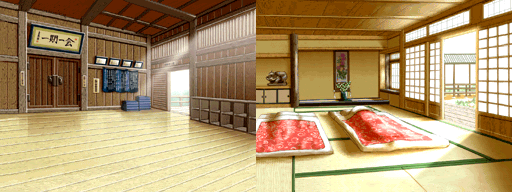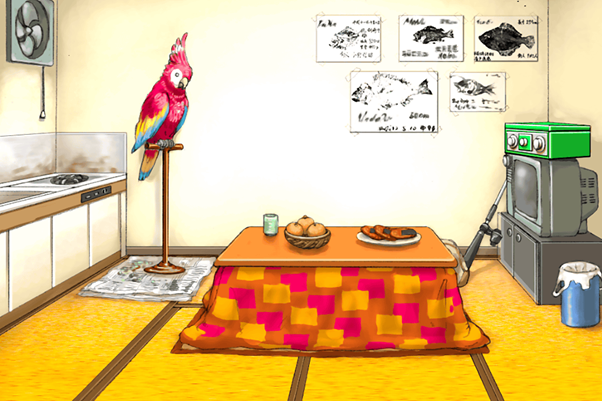
Localising Japanese Games for a Global Market: a review of Phoenix Wright: Ace Attorney
Have you ever questioned the origins of cultural references in a piece of media, let's say in a computer game or an article? Which cultural or linguistic codes are embedded into a national identity? And how are they then transmitted through media?
The Americanization of games
As a child, I loved playing Nintendo DS games such as Animal Crossing and Pokémon. I never had an issue with the fact that those games were all in English. I did not always understand everything but I either asked my parents or just continued as best as I could. I never realised that the English version games were often translated versions of the original Japanese versions and I never wondered why there was no Dutch version available.
Games such as Animal Crossing and Pokémon take place in imaginary worlds that are similar to ours but are not exactly the same. This means that it is not necessary to translate the cultural references, the text itself is enough. This is not the case for a game such as Phoenix Wright, which originated from Japan but was then culturally interpreted and translated for the English-speaking market. The game is saturated with Japanese cultural references which would impose challenges for a global audience with no prior knowledge of Japanese cultural phenomena. In order to avoid cultural misunderstandings and preserve consumers' pleasure from playing, the setting and original law cases were transported from the Japanese context into a more Westernized one, the USA.
However, does it mean that the Western audience could not equally enjoy and understand the original settings, just like it happened with the overall positive reception of the English-speaking version of Phoenix Wright: Ace Attorney? What are the underpinning reasons for Westernizing, or Americanizing, the game and to what extent is it necessary to substitute one set of cultural realia with another one in order to gain worldwide recognition? Why is an Americanised game more playable for a Dutch person such as myself while a Japanese game is not (or is it)?
What is Phoenix Wright?
Phoenix Wright: Ace Attorney is a detective-courtroom game by game company Nintendo. In the game, you play as beginner attorney Phoenix Wright who has to defend various (innocent) clients in a court of law. The player has to guide Phoenix Wright through two game elements: investigations and trials. The characters are usually exaggerated and so their responses and emotions are often amplified. The trial system that is in place is unlike anything in the world where suspects are guilty until proven innocent. This gives the game higher stakes since Phoenix’s task is thus to prove that his defendants are innocent.
The game was originally launched in 2001 in Japan for the Game Boy Advance and was rereleased in 2005 for the Nintendo DS. The re-release was also the first translated version of Phoenix Wright that was launched in the US and Europe. Since the following games (Justice for All and Trials and Tribulations) contained a lot of references to Japanese culture, the translation changes made for the first Phoenix Wright had a big impact on the consequent entries in the series. By moving the translated version to the US, the production team had to find creative ways how to preserve the flow of the game but substitute many cultural references and create new meaningful connections. The final translated product preserved little cultural resemblance with the original version. One of the main techniques used for translating any kind of textual or verbal content from the source language (in this case, Japanese) into the target language (the English language as a global means of communication, rather than its connection to one particular country) is called localisation.
What is localisation?
Localisation can be explained as the process of making a product, in this case, a game, more suitable for a particular country (Cambridge Dictionary, n.d.). Phoenix Wright: Ace Attorney, its original name Gyakuten Saiban Yomigaeru Gyakuten, was created by Japanese creators for the Japanese public. This, naturally, means that there are a lot of references to Japanese culture in the games, which had to be addressed by the localisation team while preparing the game for the 'global', mostly Western audience.
Localisation is quite a common occurrence when translating Japanese media to a global audience. Anime and manga are also often translated into English. An example of Pokémon anime can serve as an entry point to the issue of localisation. The level of localisation in Pokémon is not remarkably high because it is set in the original world with fantasy and magical elements that do not resemble the reality of players. Despite this fact, some references to Japanese culture had to be translated to make it suitable for a different audience. An infamous example is the ‘jelly-filled doughnuts’. In the Pokémon anime, Brock calls onigiri, Japanese rice balls, jelly-filled doughnuts. This scene is seen as remarkably ridiculous because the image clearly shows Brock holding triangle-shaped rice ‘balls’ with a small piece of seaweed. And therefore, it can be questioned whether some cultural substitutions and changes can be justified and necessary at all.
The localisation in Phoenix Wright has impacted various parts of the game such as the characters, storyline and artwork. By taking a deeper look into all three, we will shed light on possible reasons why the changes were made and what the consequences are for the game itself.
American or German
Phoenix Wright features a large cast of original characters with their own quirks and larger-than-life personalities. In terms of the main characters, not much was changed from the Japanese version besides their names of course. One clear example of a localised character is Manfred von Karma, an intimidating prosecutor who has never lost a case before. In the Japanese version, Manfred von Karma and his daughter Franziska, are of American origin while in the American version, they came from Germany. This shift was necessary because the setting of the English version is in the US so it would not make sense for the von Karma’s to be American. The fact that they chose to make two of the villains in the game (they want the exact opposite from Phoenix Wright and fight him in court to win) German might show a certain prejudice from the localisation team. The stereotype of the ‘evil Germans’ could be seen as anti-German sentiment left over from the Second World War. This could also be said for the Japanese version since the two prosecutors are American in that version.
The USA with a Japanese twist
Playing the Ace Attorney games, the first thing one might notice is that the game indeed takes place in the US while it is a Japanese game. This change was made because of an episode in the first game that dealt with time zones. Therefore, the localisation team had to decide where the game was taking place and they decided on the United States. However, even though this did not make a huge difference to the first game, it became more of an issue for later instalments since certain parts of those games would take place in locations that were very clearly in Japan. The backstory that was created to explain the Japanese culture in the US, was that the games took place in an alternate reality where anti-Japanese sentiments and anti-immigrant laws never existed and Japanese culture could flourish and blend into American culture like other immigrant cultures (Hsu, 2014). This backstory was never fully explained in the game but it served as a way for the localisation team to imagine why the Ace Attorney world was the way it was. This explanation was mostly necessary for the location of Kurain Village which looked like a rural village in Japan. This can be seen in the images below that contain typical Japanese architecture, Japanese writing above the door and bedding on the floor.

Two background screens in Phoenix Wright: Justice for All that show the Japanese cultural elements still present in the game.
Burgers or bento boxes
The artwork in the game is also a part of the localisation process since the visuals need to match with the written text. The expectations were that the English-translated version of the game would not sell very well (Mandiberg, 2015). This resulted in a low budget which meant that the localisation team could not change everything. Consequently, there were a lot of Japanese cultural references in the first Phoenix Wright game. A clear example of this is the caretaker’s shack. The shot shows tatami flooring (woven straw mats), a kotatsu (a table frame covered by a heavy blanket with a table on top with a heat source underneath the table), and senbei (a type of Japanese rice cracker). There are some other examples like this such as a lady selling bento boxes (Japanese boxed lunches) wearing a hat decorated with an onigiri (rice ball with a piece of seaweed). These points did not directly influence the gameplay since players did not have to understand what these things exactly were before being able to progress in the game.

A screen of a scene in Phoenix Wright: Ace Attorney that shows some Japanese cultural references that did not influence the gameplay or understanding of the game.
To localise, or not to localise
In conclusion, the Phoenix Wright games were localised to a high degree to make the games more enjoyable and suitable for a global audience. In my opinion, this was done well since I was able to enjoy playing the game without getting confused about certain (Japanese) cultural references. If the localisation team had been given an unlimited budget to localise this game, they probably would have made more drastic changes such as completely re-doing some graphics for the game (removing all Japanese references such as the kotatsu). But would this have made the game better? By doing so, would the localisation team not just have made a completely new (American) game that would have resembled the Japanese game Gyakuten Saiban Yomigaeru Gyakuten?
The main motive for localising this game was obviously to make a profit of the global market so the fact that they made these changes makes sense in that context. However, I think there is also value to be found in playing games that center on cultures that are different from your own. By making the game more American, the game was made more accessible for a different market but it also lost a piece of its Japanese origin. One could argue that leaving in too much of the Japanese culture, players would become confused and frustrated if they did not understand and might spend more time researching certain aspects instead of playing the game. But you could also argue that it is more valuable to learn more about a different culture in a playful way. I believe that I would have gotten the same enjoyment out of a version of the game that was not changed to be more American.
Phoenix Wright has in my opinion been successfully localised. The game can be played without any prior knowledge of Japanese culture and even a Dutch player can understand everything (which might say something about how the world is so accustomed to American culture). However, there is a bigger question surrounding localisation: to what extent is it necessary to localise, or domesticate games? Or should they be translated so that the origin and culture of the game remain intact while potentially not transferring the full experience of the game itself?
References
Cambridge Dictionary. (n.d.) Localization. Retrieved 17/11/2020
Hsu, J. (2014). Ace Attorney Trilogy – Surprising Tidbits You Never Knew! Retrieved 18/11/2020
Mandiberg, S. (2015). Playing (with) the Trace: Localized Culture in Phoenix Wright. Retrieved 18/11/2020